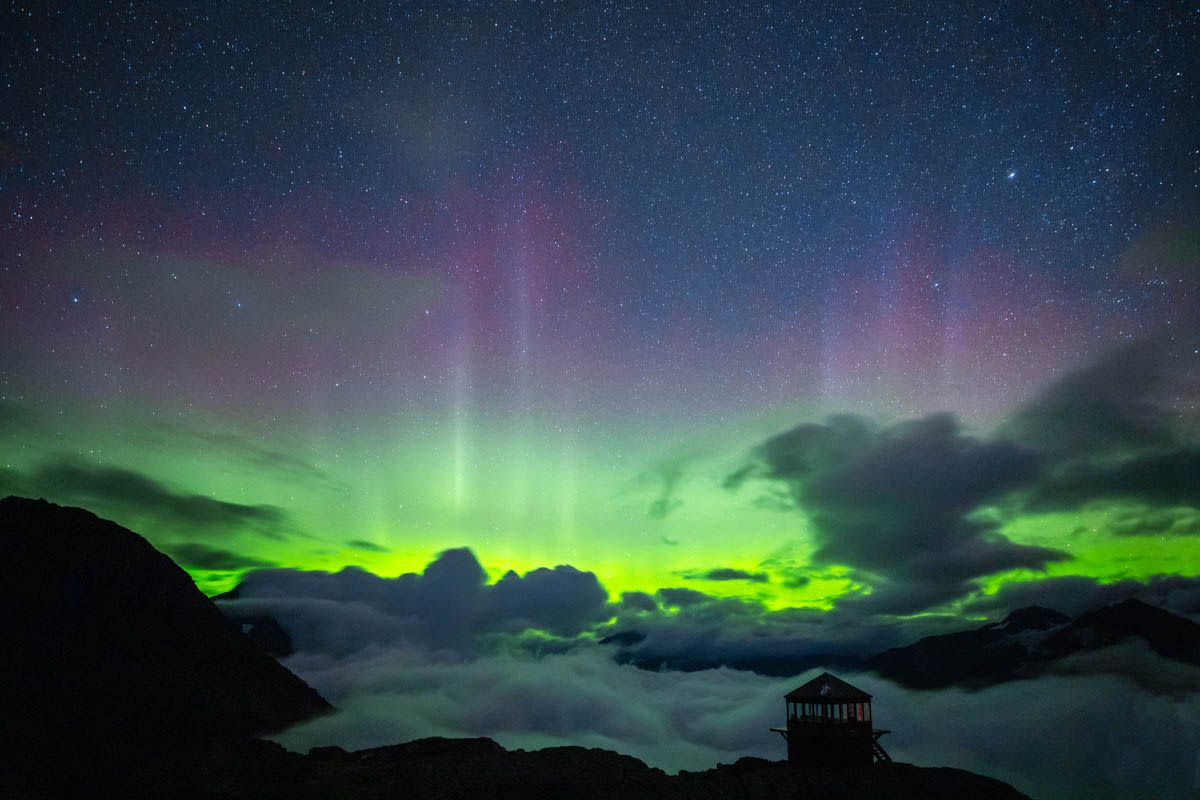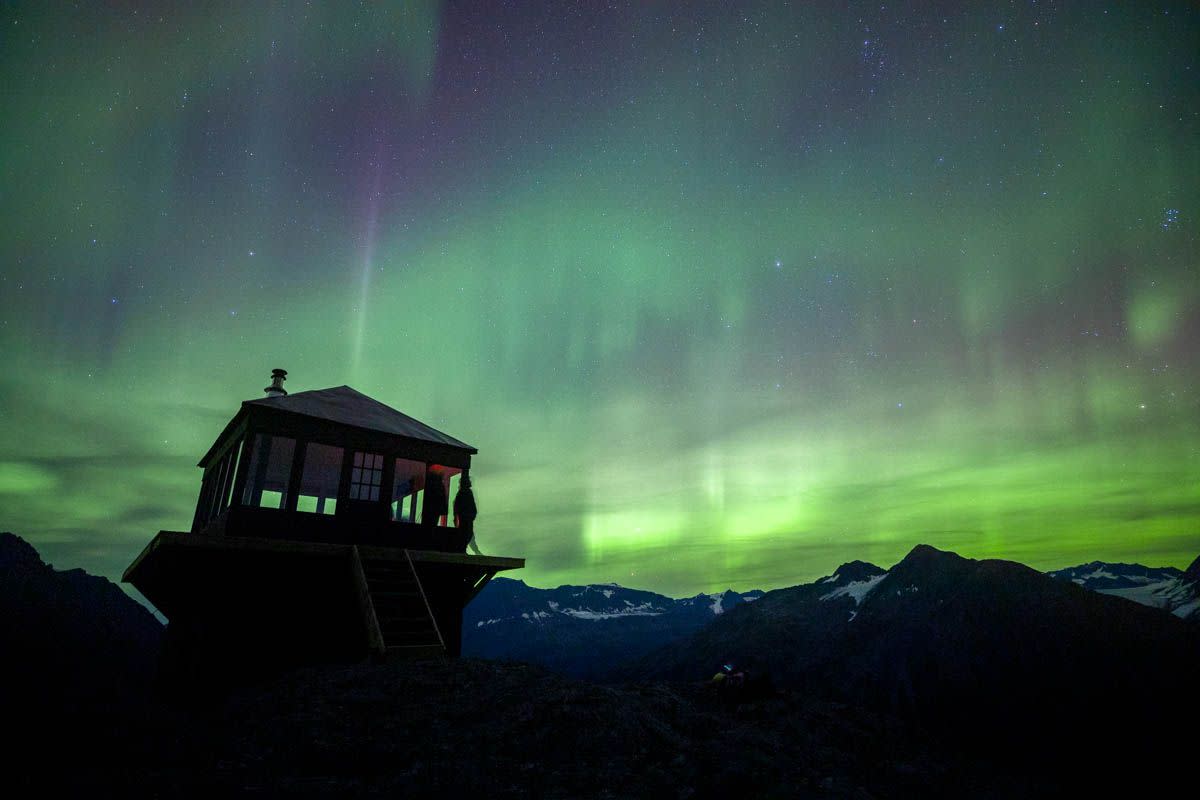The northern lights dance above Valdez, Alaska. The town is one of the best places to travel in winter for a glimpse of the natural phenomenon. Photo by Jiyeon Juno Kim.
Alaska is one of the best places in the world to view the Aurora Borealis, also known as the northern lights. This atmospheric phenomenon creates beautiful, dancing waves of vibrant light in shades of green, yellow, pink and purple. Seeing the northern lights is a bucket-list item. Many travelers from across the world visit Alaska to see this cinematic display and take advantage of the state’s many winter adventures. Being a vast state surrounded by dramatic landscapes and full of wide-open spaces, where are the best places to see northern lights in Alaska?
Thanks to the abundance of snowfall, Valdez is one of the best places to travel in winter and is also a great destination for viewing the northern lights. Known for extreme snowfall and extreme skiing, our coastal community has earned a reputation for being the ultimate destination for winter enthusiasts. But, travelers don’t have to be adrenaline junkies to enjoy all Valdez has to offer, including views of the northern lights.

The northern lights can appear in various colors and forms. Every experience viewing the northern lights is different, but equally astonishing. Photo by Jiyeon Juno Kim.
The northern lights are a natural phenomenon created when electrically charged particles from the sun enter Earth’s atmosphere and collide with gases, creating energy in the form of light. The lights usually occur 60 to 70 miles above Earth’s surface in what is called the auroral oval. The auroral oval is the ring-like area above Earth’s magnetic poles where auroral activity happens. At night, the Auroral oval extends down over Alaska, making the Last Frontier one of the best winter travel destinations for northern lights viewing.
The lights can appear in many different forms, varying from patches, to scattered clouds, to shooting rays, to streamers, arcs and rippling curtains. The intensity of the sun’s solar flares that enter Earth’s atmosphere influences the activity within the auroral oval. The lights can also appear in many different colors including yellow, green and pink which are the colors most commonly seen.
Fall in Alaska marks the return of the aurora season. The best time to see northern lights in Alaska is from mid-August to April when dwindling daylight brings dark skies. The lights decorate the night sky anytime between 9 p.m. and 3 a.m., according to the Geophysical Institute of the University of Alaska Fairbanks. The northern lights occur frequently but that does not always mean they are easy to view. Those hoping to catch a glimpse of the dazzling northern lights need to be in the right place at the right time.
 Glacier Lookout is a remote Alaska cabin perched on the side of West Point in Valdez. Far from light pollution and immersed in Valdez’s serene wilderness, it’s the perfect home base for viewing the northern lights. Photo by Glacier Lookout.
Glacier Lookout is a remote Alaska cabin perched on the side of West Point in Valdez. Far from light pollution and immersed in Valdez’s serene wilderness, it’s the perfect home base for viewing the northern lights. Photo by Glacier Lookout.
When planning where to see northern lights in Alaska, travelers should base themselves in a town that is surrounded by plenty of wide-open spaces. And it just so happens Valdez checks all the boxes! The northern lights are best seen in dark skies so it's important to be far away from light pollution from buildings, cars and street lamps. Though not always necessary, climbing to a higher elevation can also provide better viewing opportunities.
Not sure where to go for viewing the northern lights? When in doubt, ask a local! Locals of Valdez know all the best remote viewing locations with clear, dark skies. Viewing locations close to town include Valdez Glacier Lake, Robe Lake and Old Town Valdez. Both are easily accessible and Robe Lake is also home to Robe Lake Lodge & Cabins, which offers views of the lake, the surrounding Chugach Mountains and clear skies.

In the winter, Valdez Glacier Lake turns into a great winter travel destination for visitors to Valdez. The lake freezes over, perfect for ice skating, snowmachining or snowshoeing and boasts views of Valdez Glacier, towering icebergs and the northern lights. Photo by Jiyeon Juno Kim.
Travelers can venture farther from town and drive through Thompson Pass. A 2,678-foot high mountain pass that stretches 82.5 miles long and winds through the Chugach Mountains, Thompson Pass boasts views of Alaska’s most breathtaking terrain. In the winter, Thompson Pass is the snowiest place in Alaska, recording an average of 500 inches of snow per year. The snowfall transforms Thompson Pass into a top winter travel destination for outdoor enthusiasts.
By day, travelers can visit Thompson Pass to embark on winter adventures like heli-skiing, snowboarding, snow machining, fat tire biking, cross country skiing or snowshoeing. By night, travelers will find plenty of campgrounds and open spaces far from light pollution with spectacular 360-degree mountain views, clear skies and opportunity for a glimpse of the northern lights.
For those who prefer to take in the lights from the warmth of their vehicle, the highway through Thompson Pass is well-maintained and is an idyllic drive. Between winter adventures and northern lights viewing, it’s no wonder Valdez is one of the best winter travel destinations!

When planning winter travel to Valdez, Glacier Lookout provides visitors an adventurous Alaska experience with unmatched views of the northern lights. Photo from Glacier Lookout.
For a fun, winter travel getaway, travelers can book a stay at Glacier Lookout. Located outside of Valdez, Glacier Lookout is a remote Alaska lodge perched on a mountain surrounded by stunning views of glaciers and mountain peaks. Here, travelers can escape the masses and admire Valdez’s stunning scenery and the northern lights above the clouds.
“Glacier Lookout sits 3,600 feet up the backside of West Peak blocking a vast majority of light pollution and diminishing chances of cloud cover interference when viewing the northern lights,” said Zachary Sheldon, owner of Alaska Guide Company and Glacier Lookout. “Our elevation and extended northern sky corridor above Valdez Glacier also improves aurora visibility. The 4.5-foot tall windows fully envelope the building, allowing you to watch it all from inside by a warm fire, never missing a thing.”
Getting the opportunity to view this grand spectacle is a once in a lifetime experience. While planning winter travel to Valdez, it's important to note the best chance of spotting the lights is about timing. Travelers should check for local weather updates online, and can check the forecast for aurora activity provided by the University of Alaska Fairbanks online aurora forecasts.



